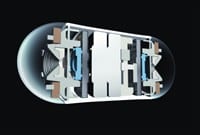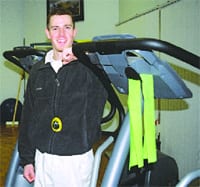Fantastic Voyage Futuristic ‘PillCam’ Shoots, And Scores
Dr. Ira Schmelkin puts a lot of himself into his work. And sometimes, that means putting his work into himself.
Schmelkin recently became his own patient, trying for the first time the revolutionary PillCam ESO, a tiny video recording device housed in a pill-shaped casing the size of a vitamin. He popped the PillCam into his mouth and swallowed; 20 minutes later the camera was at work collecting enough full-color images to make a full diagnosis on the health of his esophagus.
Schmelkin, a gastroenterologist at Berkshire Medical Center, describes the procedure, called capsule endoscopy, as phenomenal, groundbreaking, and above all, cool.
But it’s not a new concept for him. Schmelkin has been a proponent of PillCam technology for several years, and has been involved with its development for as long. There are other PillCam models on the market now, used to view other areas of the body, but Schmelkin said the PillCam ESO is one of the most significant advances the technology has seen.
“There was a need for effective diagnostic tools for the esophagus, and this fills that need,” he said. “I think this technology will absolutely take off.”
The PillCam ESO was approved by the FDA only a matter of weeks ago, but Schmelkin is already using the device to diagnose patients. Currently, he is the only physician in the Northeast using PillCam ESO technology.
Big Gulp
Schmelkin was also a pioneer of the PillCam ESO’s predecessor, the PillCam SB (small bowel), which was designed to ake photos of the small intestine to look for problems such as internal bleeding, or disorders such as Crohn’s Disease.
His fascination began during his training at Mount Sinai Hospital in Manhattan. Schmelkin was able to observe some cutting-edge methods for diagnosing gastro-intestinal problems, but realized, along with his associates, that most procedures, like traditional endoscopies using a scope, still had a few kinks to work out.
“Performing an endoscopy and a colonoscopy still leaves 20 feet of the small intestine we can’t get to,” Schmelkin explained. “In that case, an X-ray can be done, but often they are inaccurate and can’t detect things like flat lesions. There is nothing like looking at an area directly to detect possible problems.
“Exploratory surgery is another option,” he continued, “in which a very long, thin, endoscope is inserted through the nose. It leads to better images, but the procedure is difficult, time-consuming and not very cost-effective.”
Schmelkin was one of the first physicians to see the original PillCam SB in action, after it was approved by the FDA in 2001. He said even in its early trials, the PillCam yielded better images than any other procedure could, and was by far the easiest to tolerate.
“If there is something to find, the PillCam will find it 70{06cf2b9696b159f874511d23dbc893eb1ac83014175ed30550cfff22781411e5} of the time. That’s a dramatic improvement,” he said.
And his first PillCam patient, a woman who had been misdiagnosed with irritable bowel syndrome for years, and subsequently quit her job and normal activity due to excruciating abdominal pain, made him a staunch supporter of the method.
“This young lady went from doctor to doctor for 10 years,” he said. “We conducted a capsule endoscopy, found Crohn’s Disease, and put her on meds. That made me a believer very early on, and more importantly returned this woman to her life.”
Time Capsule
Schmelkin purchased a PillCam system – which includes the outside recording device a patient wears on a belt for eight hours to receive the PillCam’s images and a workstation that helps a doctor read and interpret those images – at a cost of about $30,000. Soon after, he became the self-described ‘man on the street’ for the PillCam’s manufacturer, Given Imaging, commenting on the device’s effectiveness and possible future benefits in real patient care, and conducting teaching seminars for other doctors. He said his involvement has allowed him to see firsthand the effect the technology is having on his area of practice.
“When I was practicing in Long Island, I was the first doctor to offer PillCams,” he said, “But when I left for the Berkshires, everyone had them. They are becoming the new standard.”
In fact, Schmelkin said Berkshire Medical Center already had a PillCam SB system when he arrived, though it wasn’t being utilized as much as more traditional endoscopy methods.
“BMC bought the system two years ago, but was only using it occasionally,” he said. “It’s not necessarily a money maker, but it is so effective, it is great to have that option to offer patients. We are using it much more now.”
Schmelkin said the introduction of the PillCam ESO to view and diagnose problems in the esophagus will most likely be used even more by the hospital.
He said the PillCam ESO differs from the PillCam SB in that the latter has one lens, and can take photos at a rate of about three per second; plenty for the time it takes the pill to travel through the small intestine. The trip down the esophagus, though, is much quicker, and the PillCam ESO comes equipped with two lenses and can take photos at a rate of about 14 per second.
“There is also a much greater need for diagnostic tools for the esophagus than for the small intestine,” Schmelkin said, adding that the PillCam can detect conditions of the esophagus including gastroesophageal reflux disease, esophagitis, and Barrett’s esophagus, a pre-cancerous condition.
“Preliminary studies have shown that there is a 100{06cf2b9696b159f874511d23dbc893eb1ac83014175ed30550cfff22781411e5} correlation between the PillCam ESO’s findings and those of other methods to explore the esophagus,” he noted. “We’re not missing anything.”
Schmelkin said he has confidence that PillCam technology will not only match other methods in terms of diagnosing patients, but surpass current accepted procedures as a first line of defense for patients with esophageal problems in the future, due in part to the added comfort it allows and the elimination of the fear factor, which in turn could prompt more patients to seek a doctor’s help.
Easy to Swallow
In addition, the PillCam gives doctors an independent guided tour of a patient’s digestive system; in essence, allowing another pair of eyes, or in this case two high-speed lenses, to assist in a complete, comprehensive diagnostic procedure and further guard against error or oversights.
“The exciting thing about PillCams is that there’s nothing else like it,” Schmelkin said. “But what is most gratifying is the fact that we can now find things that every other test has not been able to, and help a patient at the point where literally dozens of other tests have failed.
“We could potentially see the rates of esophageal cancer and disease drop,” he continued. “That’s what is phenomenal. That’s what is so cool.”



Comments are closed.